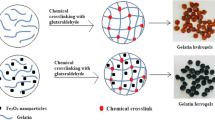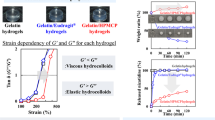Abstract
The high solubility of gelatin in neutral, basic, and acidic biofluids may not promote a controlled drug delivery as a drug carrier. The present study reports the modification of the solubility and swellability of gelatin by crosslinking with hitherto uninvestigated isophorone diisocyanate to achieve controlled drug release characteristics. The crosslinked gelatin was insoluble and swellable in biofluids and analyzed by FT-IR and proton NMR, thermal analysis, swellability and biodegradability in simulated biofluids, X-ray diffraction, biocompatibility, and in vitro drug release kinetics and mechanism with 5-Fluorouracil as model drug. Crosslinking decreased the biodegradability and solubility, and enhanced the amorphous character of gelatin. The mild decrease in thermal stability of crosslinked gelatin was attributed to the urea linkage introduced. Drug release predominately occurred via anomalous transport mechanism with mild degradative diffusion. The observed results demonstrated that crosslinked gelatin can be used as a potential carrier to achieve controlled drug release.













Similar content being viewed by others
References
Balakrishnan B, Jayakrishnan A (2005) Self-cross-linking biopolymers as injectable in situ forming biodegradable scaffolds. Biomaterials 26:3941–3951. http://dx.doi.org/10.1016/j.biomaterials.2004.10.005
Einersona NJ, Stevensa KR, Kao WJ (2002) Synthesis and physicochemical analysis of gelatin-based hydrogels for drug carrier matrices. Biomaterials 24:509–523. http://dx.doi.org/10.1016/S0142-9612(02)00369-1
Esposito E, Cortesi R, Nastruzzi C (1996) Gelatin microspheres: influence of preparation parameters and thermal treatment on chemico-physical and biopharmaceutical properties. Biomaterials 17:2009–2020. http://dx.doi.org/10.1016/0142-9612(95)00325-8
Gullapalli RP (2010) Soft gelatin capsules (softgels). J Pharm Sci 99:4107–4148. doi:10.1002/jps.22151
Kuijpers AJ, Van Wachem PB, Van Luyn MJ, Plantinga JA, Engbers GHM, Krijgsveld J, Zaat SAJ, Dankert J, Ferjen J (2000) In vivo compatibility and degradation of cross linked gelatin gels incorporated in knitted Dacron. J Biomed Mater Res 51:136–145. doi:10.1002/(SICI)1097-4636(200007)51:1<136:AID-JBM18>3.0.CO;2-W
Kuijpers AJ, Engbers GHM, Krijgsveld J, Zaat SAJ, Dankert J, Feijen J (2000) Cross linking and characterization of gelatin matrices for biomedical applications. J Biomater Sci Polym Ed 11:225–243. http://dx.doi.org/10.1163/156856200743670
Ratcliffe HJ, Hunneyball IM, Smith A, Wilson CG, Pavis SS (1984) Preparation and evaluation of biodegradable polymeric systems for the intra-articular delivery of drugs. J Pharm Pharmacol 36:431–436. doi:10.1111/j.2042-7158.1984.tb04419.x
Tabata Y, Ikada Y (1998) Protein release from gelatin matrices. Adv Drug Delivery Rev 31:287–301. http://dx.doi.org/10.1016/S0169-409X(97)00125-7
Yamamoto M, Ikada Y, Tabata Y (2001) Controlled release of growth factors based on biodegradation of gelatin hydrogel. J Biomater Sci Polym Ed 12:77–88. http://dx.doi.org/10.1163/156856201744461
Yao CH, Liu BS, Chang CJ, Hsu SH, Chen YS (2004) Preparation of networks of gelatin and genipin as degradable biomaterials. Mater Chem Phys 83:204–208. http://dx.doi.org/10.1016/j.matchemphys.2003.08.027
Young S, Wong M, Tabata Y, Mikos AG (2005) Gelatin as a delivery vehicle for the controlled release of bioactive molecules. J Controlled Release 109:256–274. http://dx.doi.org/10.1016/j.jconrel.2005.09.023
Apostolov AA, Boneva D, Vassileva E, Mark JE, Fakirov S (2000) Mechanical properties of native and cross linked gelatins in a bending deformation. J Appl Polym Sci 76:2041–2048. doi:10.1002/(SICI)1097-4628(20000628)76:14<2041:AID-APP6>3.0.CO;2-6
Bigi A, Cojazzi G, Panzavolta S, Roveri N, Rubini K (2002) Stabilization of gelatin films by cross linking with genipin. Biomaterials 23:4827–4832. http://dx.doi.org/10.1016/S0142-9612(02)00235-1
Gupta P, Vermani K, Garg S (2002) Hydrogels: from controlled release to pH-responsive drug delivery. Drug Discov Today 7:569–579. http://dx.doi.org/10.1016/S1359-6446(02)02255-9
Honda I, Arai K, Mitomo H (1997) Characterization of cross-links introduced in gelatin. J Appl Polym Sci 64:1879–1892. doi:10.1002/(SICI)1097-4628(19970606)64:10<1879:AID-APP2>3.0.CO;2-F
Kallinteri P, Antimisiaris SG (2001) Solubility of drugs in the presence of gelatin: effect of drug lipophilicity and degree of ionization. Int J Pharm 22:219–226. http://dx.doi.org/10.1016/S0378-5173(01)00688-3
Ofner CM III, Bubnis WA (1996) Chemical and swelling evaluations of amino group cross linking in gelatin and modified gelatin matrices. Pharm Res 13:1821–1827. doi:10.1023/A:1016029023910
Thakur G, Mitra A, Rousseau D, Basak A, Sarkar S, Pal K (2011) Cross linking of gelatin-based drug carriers by genipin induces changes in drug kinetic profiles in vitro. J Mater Sci Mater Med 22:115–123. doi:10.1007/s10856-010-4185-3
Vassileva E, Apostolov AA, Evstatiev M, Pashkuleva I, Friedrich K (2002) Effect of processing conditions on mechanical properties of pretreated gelatin samples. Int J Polym Mater 51:103–132. doi:10.1080/00914030213027
Yao CH, Liu BS, Hsu SH, Chen YS, Tsai CC (2004) Biocompatibility and biodegradation of a bone composite containing tricalcium phosphate and genipin crosslinked gelatin. J Biomed Mater Res 69:709–717. doi:10.1002/jbm.a.30045
Bertoldo M, Bronco S, Gragnoli T, Ciardelli F (2007) Modification of gelatin by reaction with 1, 6-diisocyanatohexane. Macromol Biosci 7:328–338. doi:10.1002/mabi.200600215
Sarkar S, Chourasia A, Maji S, Sadhukhan S, Kumar S, Adhikari B (2006) Synthesis and characterization of gelatin based polyester urethane scaffold. Bull Mater Sci 29:475–484
Huang L, Sui W, Wang Y, Jiao Q (2010) Preparation of chitosan/chondroitin sulfate complex microcapsules and application in controlled release of 5-fluorouracil. Carbohydr Polym 80:168–173. http://dx.doi.org/10.1016/j.carbpol.2009.11.007
Sunshine I (1982) Handbook of spectrophotometric data of drugs. CRC Press, Boca Raton, FL
Munday DL, Fassihi AR (1995) In vitro–in vivo correlation studies on a novel controlled release theophylline delivery system and on Theo-Dur tablets. Int J Pharm 118:251–255. http://dx.doi.org/10.1016/0378-5173(94)00391-H
Arnold RG, Nelson JA, Verbanc JJ (1957) Recent advances in isocyanate chemistry. Chem Rev 57:47–76. doi:10.1021/cr50013a002
Shantha KL, Udaya Bala, Panduranga Rao K (1995) Tailor-made chitosans for drug delivery. Eur Polym J 31:377–382. http://dx.doi.org/10.1016/0014-3057(94)00177-4
Mosmann T (1983) Rapid colorimetric assay for cellular growth and survival: application to proliferation and cytotoxicity assays. J Immunol Methods 65:55–63. http://dx.doi.org/10.1016/0022-1759(83)90303-4
Monks A, Scudiero D, Skehan P, Shoemaker R, Paull K, Vistica D, Hose C, Langley J, Cronise P, Wolff AV, Goodrich MG, Campbell H, Mayo J, Boyd M (1991) Feasibility of a high-flux anticancer drug screen using a diverse panel of cultured human tumor cell lines. J Natl Cancer Inst 83:757–766. doi:10.1093/jnci/83.11.757
Dakin HD (1920) Amino-acids of gelatin. J Biol Chem 44:499–529
Bergmann M, Stein WH (1939) A new principle for the determination of amino acids, and its application to collagen and gelatin. J Biol Chem 128:217–232
Yakimets I, Wellner N, Smith AC, Wilson RH, Farhat IJM (2005) Mechanical properties with respect to water content of gelatin films in glassy state. Polymer 46:12577–12585. http://dx.doi.org/10.1016/j.polymer.2005.10.090
Hayashi T, Mukamel S (2008) Two-dimensional vibrational lineshapes of amide III, II, I and A bands in a helical peptide. J Mol Liq 141:149–154. http://dx.doi.org/10.1016/j.molliq.2008.02.013
Hong K, Park S (1999) Preparation of polyurea microcapsules with different composition ratios: structures and thermal properties. Mater Sci Eng A 272:418–421. http://dx.doi.org/10.1016/S0921-5093(99)00509-2
Park SH, Lee JS, Suh KD (1998) Low density polyethylene with an isocyanate functional group. J Mater Sci 33:5145–5148. doi:10.1023/A:1004467500885
Williamson MP, Asakura T (1997) Protein chemical shifts. In: Reid DG (ed) Protein NMR techniques (methods in molecular biology). Humana Press, Totowa, NJ, pp 53–59
Sandler SR, Karo W (1992) Polymer syntheses. Academic Press, London, pp 218–220
Pezron I, Djabourov M, Bosio L, Leblond J (1990) X-ray diffraction of gelatin fibers in the dry and swollen states. J Poly Sci Part B: Polym Phys 28:1823–1839. doi:10.1002/polb.1990.090281013
Peña C, Caba K, Eceiza A, Ruseckaite R, Mondragon I (2010) Enhancing water repellence and mechanical properties of gelatin films by tannin addition. Bioresource Technol 101:6836–6842. http://dx.doi.org/10.1016/j.biortech.2010.03.112
Bosch E, Gielens C (2003) Gelatin degradation at elevated temperatures. Int J Biol Macromol 32:129-138. http://dx.doi.org/10.1016/S0141-8130(03)00046-1
Chen L, Remondetto G, Rouabhia M, Subirade M (2008) Kinetics of the breakdown of cross-linked soy protein films for drug delivery. Biomaterials 29:3750–3756. http://dx.doi.org/10.1016/j.biomaterials.2008.05.025
Ritger PL, Peppas NA (1987) A simple equation for description of solute release ii. Fickian and anomalous release from swellable devices. J Controlled Release 5:37–42. http://dx.doi.org/10.1016/0168-3659(87)90035-6
Costa P, Lobo JMS (2001) Modeling and comparison of dissolution profiles. Eur J Pharm Sci 13:123–133. http://dx.doi.org/10.1016/S0928-0987(01)00095-1
Lara MG, Bentley MVLB, Collett JH (2005) In vitro drug release mechanism and drug loading studies of cubic phase gels. Int J Pharm 293:241–250. http://dx.doi.org/10.1016/j.ijpharm.2005.01.008
Acknowledgments
The authors acknowledge with thanks the Department of Biotechnology (DBT), Government of India for the financial support, the management of Bannari Amman Institute of Technology (BIT), Sathyamangalam-638 401 for providing the facilities, Department of chemistry and sophisticated instrumentation facility of Indian Institute of Technology, Chennai, for recording TG traces, and Dr. Adhirajan of Kovai Medical Centre and Hospital, Coimbatore for the cytotoxicity studies. The co-author, Mr. V. Vijayakumar also thanks DBT for awarding the fellowship.
Author information
Authors and Affiliations
Corresponding author
Rights and permissions
About this article
Cite this article
Subramanian, K., Vijayakumar, V. Evaluation of isophorone diisocyanate crosslinked gelatin as a carrier for controlled delivery of drugs. Polym. Bull. 70, 733–753 (2013). https://doi.org/10.1007/s00289-012-0821-z
Received:
Revised:
Accepted:
Published:
Issue Date:
DOI: https://doi.org/10.1007/s00289-012-0821-z




